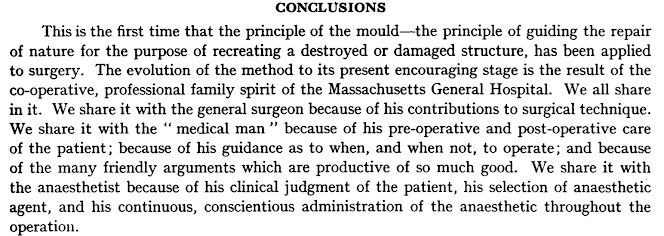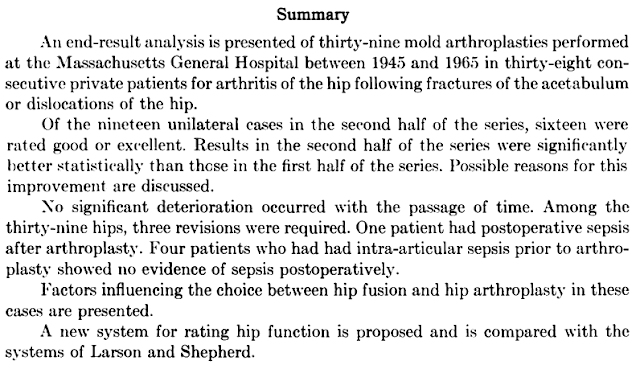The first ream and run procedures were not done for shoulder arthritis, but rather for arthritis of the hip.
In a classic article by M. N. Smith Peterson (see this link), the author reviewed his treatment of hip arthritis by reaming the acetabulum and covering the femoral head with a mould (or mold) made of glass. This thought was apparently inspired by a shard of glass he found in a patient’s back with a benign synovial-like membrane around it. He tried various materials for the mould, including glass and vitallium:

On the acetabular side, he used a convex reamer very similar to those we use today for the ream and run
His concept is expressed below

His conclusion is shown below
Here is an example of a 6.5 year followup.
He used this method to take down hip fusions.
In 1969 W.H.Harris published, "Traumatic arthritis of the hip after dislocation and acetabular fractures: treatment by mold arthroplasty. An end-result study using a new method of result evaluation. This was a case series of mold arthroplasties performed between 1945 and 1965 by three orthopaedic icons: M.N. Smith-Peterson, Otto E. Aufranc, and Morton Smith-Peterson. In this procedure the acetabulum was reamed and the reamed femoral head was covered with a metallic cup. Some of the preoperative and followup radiographs are shown below.
All of the procedures is-crc standard arthroplasties with
decortication arid reaming of both the head and acetabulum except for tis’o in ‘which
the cup was placed on the mid-portion of the femoral head ansd tivo in is-hich the cup
‘was seated against the periphery of the acetabulum in preference to inserting it
more deeply insto an e;;kxploded socket
The clinical results as summarized by the authors are summarized below.
kxploded socket
While there are few histological studies of the effect of this early hip procedure the one below suggests the presence of fibrocartilage over the reamed acetabular surface.

This was actually this figure that inspired our exploration of the ream and run procedure. Histology from an animal model shown below immediately after reaming (left) and six months after showing growth of fibrocartilage over the reamed surface (right) (see this
link).
In case you're curious, American English has no "mould", and British English has no "mold". In other words, the word referring to (1) the various funguses that grow on organic matter or (2) a frame for shaping something is spelled the same in both uses, and the spelling depends on the variety of English.
Here's an example of the durability of a reamed glenoid with a humeral hemiarthroplasty "mold". A 62 year old physically active man presented with pain and stiffness in the right shoulder. On presentation he had these x-rays.
To avoid the risks and limitations associated with a prosthetic glenoid component, he elected to have the ream and run procedure.
A one year after his procedure he had full return of comfort and function and these radiographs
Here are his x-rays at two years after surgery
At 10 years his function remained excellent. His x-rays at 10 years are shown here. Note the thin soft tissue layer between the prosthetic humeral head and the reamed glenoid bone.
Our technique for the ream and run is shown in this link.
How you can support research in shoulder surgery Click on this link.
Here are some videos that are of shoulder interest
Shoulder arthritis - what you need to know (see this link). How to x-ray the shoulder (see this link). The total shoulder arthroplasty (see this link). The cuff tear arthropathy arthroplasty (see this link). The reverse total shoulder arthroplasty (see this link). The smooth and move procedure for irreparable rotator cuff tears (see this link). Shoulder rehabilitation exercises (see this link).
Follow on twitter: Frederick Matsen (@shoulderarth)




























